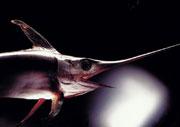 Warm eyes work faster.© Punchstock
Warm eyes work faster.© PunchstockZoologists have answered the intriguing question of why swordfish keep their eyes warm while the rest of the body remains resolutely cold-blooded: it's all the better to see their prey with.
Heat-assisted eyes work more than ten times faster than those cooled to the coldest deep-sea temperatures of around 3 ºC, report Kerstin Fritsches of the University of Queensland in Brisbane, Australia, and her colleagues. This increased 'temporal resolution' helps swordfish to catch dinner in the inky depths.
Researchers already knew that swordfish (Xiphias gladius) can selectively warm their eyes and brains. The fish have a specially adapted heating organ in the muscle next to their tennis-ball-sized eyes, which can raise temperatures in the surrounding tissue some 10-15 ºC above that of the water in which the fish is swimming.
But heating takes a lot of energy, and until now experts were confused as to why the swordfish goes to the trouble. Heat is lost around 3,000 times more quickly to water than to air, and of the 25,000 or so species of bony fish, only 22 - including swordfish, marlin, tuna and some sharks - have been found to possess any kind of heating mechanism.
Flicker fusion
Evaluating the benefits of swordfishes' warm eyes has been difficult because the fish live in the remote open ocean, says Fritsches. She and her team had to travel into the middle of the Pacific Ocean, some 1,000 kilometres from Hawaii, to catch swordfish and tuna.
They took retinas from the fish and, over a range of temperatures, tested the speed at which the membranes could distinguish movement by measuring the 'flicker fusion frequency'. This is the point at which a flickering light becomes too rapid for the retina to generate separate nerve impulses for each individual flash.
The swordfish retinas' performance improved greatly as the temperature rose, the researchers report in Current Biology1. Retinas from the warm-blooded tuna also improved with temperature but only by about half as much, perhaps reflecting the fact that their whole-body heating has evolved for its general advantages in areas such as locomotion, not just vision.
Quick fire
The heater allows swordfish to capture valuable light more quickly, helping them to catch sight of speedy prey such as squid. "It's similar to a camera," Fritsches explains. "Fast movement will result in a blurred picture." So the fish have developed a way to capture the light more quickly, effectively giving them a faster 'shutter speed'.
The theory is boosted by the fact that swordfish live at temperate latitudes in which sea temperatures drop swiftly with increasing depth. Eye heaters allow them to delve deep in the water in search of a meal, says Fritsches. "It has really helped them to expand their hunting grounds and make them the successful hunters they are."
More measurements are needed, however, to prove that warm eyes are indeed an adaptation for faster vision, comments Ian Johnston, a fish biologist at the University of St Andrews, UK. He points out that the researchers' results stop several degrees short of the 28 ºC to which the fish have been known to heat their eyes in the wild.
He also suggests that swordfish eyes should be compared with those of completely cold-blooded fish of a similar size, and to those of the butterfly mackerel, a fish from the tuna family that specifically warms its eyes, although it uses a different mechanism. "It would be worth doing a more extensive study using a wider range of species and temperatures," he told news@nature.com.
-
References
- Fritsches, K. A., Brill, R. W. & Warrant, E. J. Curr. Biol. 15, 55−58 (2005). | Article |
